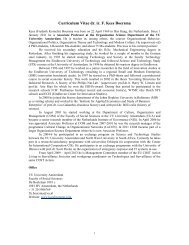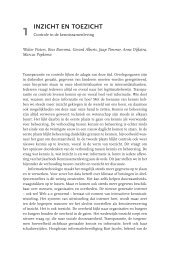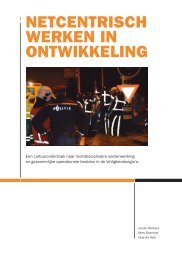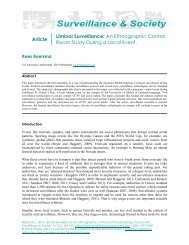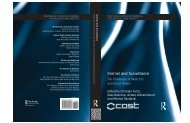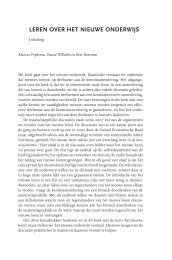Access article in PDF - Project MUSE - Johns Hopkins University
Access article in PDF - Project MUSE - Johns Hopkins University
Access article in PDF - Project MUSE - Johns Hopkins University
Create successful ePaper yourself
Turn your PDF publications into a flip-book with our unique Google optimized e-Paper software.
70 BOERSMA<br />
the basis for all X-ray tubes manufactured s<strong>in</strong>ce his groundbreak<strong>in</strong>g<br />
work. Coolidge developed his <strong>in</strong>vention at the GE Research Laboratory<br />
<strong>in</strong> Schenectady, New York. GE’s laboratory is often cited as an<br />
example of “how to do research <strong>in</strong> <strong>in</strong>dustry,” and both historians<br />
and contemporaries referred to GE as an <strong>in</strong>ternational trendsetter. 14<br />
GE had a formalized managerial hierarchy and a middle management<br />
level for departments such as manufactur<strong>in</strong>g, eng<strong>in</strong>eer<strong>in</strong>g, and research.<br />
15 The climate at GE allowed Coolidge to become a brilliant<br />
experimentalist. Patented and <strong>in</strong>troduced <strong>in</strong> 1913, the “Coolidge<br />
tube” comb<strong>in</strong>ed the scientist’s own tungsten research with his colleague<br />
Irv<strong>in</strong>g Langmuir’s achievements <strong>in</strong> vacuum technology to create<br />
a hot cathode vacuum tube. By 1913 the GE laboratory was manufactur<strong>in</strong>g<br />
Coolidge X-ray tubes on a small scale. 16<br />
Coolidge’s f<strong>in</strong>d<strong>in</strong>gs ga<strong>in</strong> significance <strong>in</strong> the context of X-ray technology<br />
and its potential value. Because they possess a great deal of<br />
energy, X-rays can easily penetrate materials composed of light<br />
atoms, whereas they are absorbed by substances composed of heavier<br />
atoms, such as those found <strong>in</strong> metals. When rays that have been<br />
aimed at an object are projected onto a screen, the parts of the object<br />
that have absorbed the rays will become visible as white patches,<br />
thus reveal<strong>in</strong>g, for <strong>in</strong>stance, the bone structure of a human body:<br />
bones absorb X-rays while the softer parts of the body allow the rays<br />
to pass through. X-ray tubes were widely used by physicians to exam<strong>in</strong>e<br />
lungs and to detect bone fractures; there were also myriad<br />
applications for the technology <strong>in</strong> medical therapy. X-rays also had<br />
<strong>in</strong>dustrial uses: researchers used them, for example, to study the<br />
structure of metals.<br />
14. See for example, David A. Hounshell, “The Evolution of Industrial Research<br />
<strong>in</strong> the United States,” <strong>in</strong> Eng<strong>in</strong>es of Innovation: U.S. Industrial Research<br />
at the End of an Era, ed. Richard S. Rosenbloom and William J. Spencer (Boston,<br />
1996), 13–85; and Thomas A. Boyd, Research: The Pathf<strong>in</strong>der of Science and<br />
Industry (New York, 1935).<br />
15. Louis Galambos, “The American Economy and the Reorganization of the<br />
Sources of Knowledge,” <strong>in</strong> The Organization of Knowledge <strong>in</strong> Modern America,<br />
1880–1920, ed. Alexandra Oleson and John Voss (Baltimore, Md., 1979), 269–82.<br />
See also the Schenectady Museum Archives, Hammond File L 6198; George Wise,<br />
Willis R. Whitney, General Electric, and the Orig<strong>in</strong> of U.S. Industrial Research<br />
(New York, 1985), 72. See also Alfred D. Chandler, Jr., Scale and Scope: The<br />
Dynamics of Industrial Capitalism (Cambridge, Mass., 1990), especially pp. 220–<br />
22 and 537–38, and W. Bernard Carlson, “Competition and Consolidation <strong>in</strong> the<br />
Electrical Manufactur<strong>in</strong>g Industry, 1889–1892,” <strong>in</strong> Technological Competitiveness:<br />
Contemporary and Historical Perspectives on the Electrical, Electronics, and<br />
Computer Industries, ed. William Aspray (New York, 1993), 287–311.<br />
16. Reich, Mak<strong>in</strong>g of American Industrial Research, chap. 4. The American<br />
Institute of Electrical Eng<strong>in</strong>eers awarded Coolidge the Edison Medal <strong>in</strong> 1926 for<br />
the orig<strong>in</strong>ation of ductile tungsten and the fundamental improvement of the X-<br />
ray tube.




